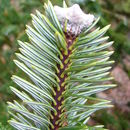Comments
provided by eFloras
The timber is used for construction, and tannin is extracted from the bark.
- license
- cc-by-nc-sa-3.0
- copyright
- Missouri Botanical Garden, 4344 Shaw Boulevard, St. Louis, MO, 63110 USA
Description
provided by eFloras
Trees to 20 m tall; bark dark gray, flaking; branchlets red-brown or brown, darkened or turning dark gray in 2nd or 3rd year, initially puberulent; winter buds globose or obovoid, resinous. Leaves ascending on upper side of branchlets, pectinately arranged in 2 lateral sets on lower side, bright green adaxially, linear, (1.5-)2-3(-4) cm × 2-2.5 mm, stomatal lines in 2 white bands abaxially, resin canals 2, marginal, apex emarginate, rarely acute or obtuse. Seed cones sessile, dark brown-purple or black-brown at maturity, cylindric or shortly so, 7-12 × 3.5-6 cm. Seed scales at middle of cones flabellate-trapeziform, 1.3-2 × 1.3-2.3 cm, margin auriculate laterally. Bracts cuneate-obovate, distal margin broadly rounded, apex with exserted, straight or recurved cusp 4-7 mm. Seeds ca. 1 cm; wing light brown or red-brown, broadly cuneate. Pollination May, seed maturity Oct-Nov.
- license
- cc-by-nc-sa-3.0
- copyright
- Missouri Botanical Garden, 4344 Shaw Boulevard, St. Louis, MO, 63110 USA
Distribution
provided by eFloras
SW Sichuan, E Xizang, NW Yunnan
- license
- cc-by-nc-sa-3.0
- copyright
- Missouri Botanical Garden, 4344 Shaw Boulevard, St. Louis, MO, 63110 USA
Habitat
provided by eFloras
* Mountains; 2500-4200 m.
- license
- cc-by-nc-sa-3.0
- copyright
- Missouri Botanical Garden, 4344 Shaw Boulevard, St. Louis, MO, 63110 USA
Synonym
provided by eFloras
Abies chengii Rushforth; A. delavayi Franchet var. forrestii (Coltman-Rogers) A. B. Jackson; A. forrestii var. chengii (Rushforth) Silba.
- license
- cc-by-nc-sa-3.0
- copyright
- Missouri Botanical Garden, 4344 Shaw Boulevard, St. Louis, MO, 63110 USA
Cyclicity
provided by Plants of Tibet
Pollination in May; seed maturity from October to November.
Distribution
provided by Plants of Tibet
Abies forrestii is occurring in SW Sichuan, E Xizang, NW Yunnan of China.
Evolution
provided by Plants of Tibet
Phylogenetic analysis of restriction site data from the nuclear ribosomal DNA internal transcribed spacer region (ITS) was conducted for Abies to evaluate different infrageneric classification schemes (Xiang et al., 2004). Results indicated seven subclades were resolved: (1) sect. Bracteata, (2) sect. Balsamea (excluding A. kawakamii), (3) sect. Amabilis, (4) an eastern Asian group including sect. Momi, part of sect. Pseudopicea, and A. kawakamii, (5) core of sect. Pseudopicea, (6) a Mediterranean-south-western Asian group containing sect. Abies and sect. Piceaster and (7) sect. Nobilis.
General Description
provided by Plants of Tibet
Trees to 20 m tall; bark dark gray, flaking; branchlets red-brown or brown, darkened or turning dark gray in 2nd or 3rd year, initially puberulent; winter buds globose or obovoid, resinous. Leaves ascending on upper side of branchlets, pectinately arranged in 2 lateral sets on lower side, bright green adaxially, linear, 2-3 cm long, 2-2.5 mm wide, stomatal lines in 2 white bands abaxially, resin canals 2, marginal, apex emarginate, rarely acute or obtuse. Seed cones sessile, dark brown-purple or black-brown at maturity, cylindric or shortly so, 7-12 cm long, 3.5-6 cm wide. Seed scales at middle of cones flabellate-trapeziform, 1.3-2 cm long, 1.3-2.3 cm wide, margin auriculate laterally. Bracts cuneate-obovate, distal margin broadly rounded, apex with exserted, straight or recurved cusp 4-7 mm. Seeds ca. 1 cm; wing light brown or red-brown, broadly cuneate.
Habitat
provided by Plants of Tibet
Growing in mountains; 2500-4200 m.
Threats
provided by Plants of Tibet
Abies forrestii is reported be Lower Risk/least concern (Conifer Specialist Group, 1998).
Uses
provided by Plants of Tibet
The timber of Abies forrestii is used for construction, and tannin is extracted from the bark.
Abies forrestii
provided by wikipedia EN
Abies forrestii is a species of conifer in the family Pinaceae, endemic to China. It is named after the Scottish botanist and plant-hunter George Forrest (1873–1932), who discovered it for western science in Yunnan province. Its common names include Forrest's fir.[1]
This species is variable in morphology, and there are several varieties. Some of these are treated as separate species.[1] In general, it grows up to about 20 meters tall. The needles are 1.5 to 4 centimeters long and the purplish, brown, or black cones are 7 to 12 centimeters long.[2]
Varieties include:[1]
-
A. forrestii var. ferreana (syn. Abies chayuensis)
-
A. forrestii var. forrestii (syn. Abies chengii)
-
A. forrestii var. georgei – George's fir
-
A. forrestii var. smithii
This species grows in the mountains of southwestern China, sometimes at high altitudes. At lower elevations it grows in mixed forests with species such as Picea likiangensis, Larix potaninii, Tsuga dumosa, and Betula albosinensis. It is sometimes a dominant member of the canopy in rhododendron woodlands.[1]
This tree is used for construction wood and pulp.[1]
References

- license
- cc-by-sa-3.0
- copyright
- Wikipedia authors and editors
Abies forrestii: Brief Summary
provided by wikipedia EN
Abies forrestii is a species of conifer in the family Pinaceae, endemic to China. It is named after the Scottish botanist and plant-hunter George Forrest (1873–1932), who discovered it for western science in Yunnan province. Its common names include Forrest's fir.
This species is variable in morphology, and there are several varieties. Some of these are treated as separate species. In general, it grows up to about 20 meters tall. The needles are 1.5 to 4 centimeters long and the purplish, brown, or black cones are 7 to 12 centimeters long.
Varieties include:
A. forrestii var. ferreana (syn. Abies chayuensis) A. forrestii var. forrestii (syn. Abies chengii) A. forrestii var. georgei – George's fir A. forrestii var. smithii
This species grows in the mountains of southwestern China, sometimes at high altitudes. At lower elevations it grows in mixed forests with species such as Picea likiangensis, Larix potaninii, Tsuga dumosa, and Betula albosinensis. It is sometimes a dominant member of the canopy in rhododendron woodlands.
This tree is used for construction wood and pulp.
- license
- cc-by-sa-3.0
- copyright
- Wikipedia authors and editors

